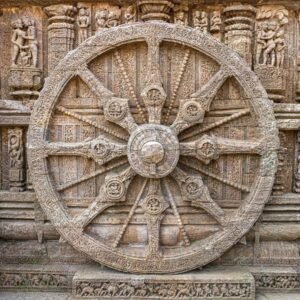
CSIP : PRELIMS BOOSTER SERIES – 45 ART & CULTURE
KONARK SUN TEMPLE
Why in News?
G20 Summit: India showcases Konark Wheel of Odisha at welcome handshake for world leaders
About Konark Sun Temple
The Konark Sun Temple, located in the coastal town of Konark in the Indian state of Odisha, stands as a magnificent testament to India’s architectural and artistic heritage. This ancient temple is renowned for its awe-inspiring architecture, intricate carvings, and historical significance. Here’s a closer look at the Konark Sun Temple.
Architectural Marvel:The Konark Sun Temple, also known as the Black Pagoda, was built in the 13th century during the reign of King Narasimhadeva I of the Eastern Ganga Dynasty. It is celebrated for its exceptional Kalinga-style architecture, characterized by intricate stone carvings, impressive sculptures, and a stunning layout.
Sun God Worship:The temple is dedicated to Lord Surya, the Sun God, and is designed as a colossal chariot with 24 intricately carved stone wheels, symbolizing the chariot of the Sun God. The temple’s main sanctum once housed a massive stone idol of Lord Surya, which has since been lost to time and historical events.
Erotic Sculptures: One of the most striking features of the Konark Temple is its depiction of intricate and explicit erotic sculptures. These carvings, while artistically significant, have also contributed to the temple’s fame. They are believed to represent various aspects of human life and emotions.
Architectural Precision: The temple’s construction demonstrates remarkable engineering and architectural precision. The main temple structure is designed in such a way that the first rays of the morning sun would pass through the main
entrance and hit the presiding deity within the sanctum, a testament to the temple’s dedication to the Sun God.
UNESCO World Heritage Site: In recognition of its architectural and historical importance, the Konark Sun Temple was designated as a UNESCO World Heritage Site in 1984. It is also protected as a national monument under the Ancient Monuments and Archaeological Sites and Remains Act of India.


